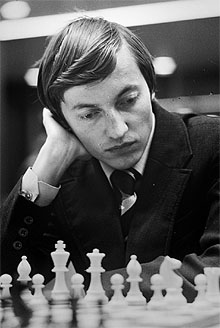|
| Magriel's NYT Columns |

Anatoly Karpov was world chess
champion from 1975 to 1985. Chess and backgammon, the two oldest board games, have many elements in common. They are both profound games of position and strategy, in which the ability to recognize visual patterns is critical. Many concepts, such as mobility, flexibility, tempo, and control apply to both.
Indeed, it is no coincidence that several of today’s most talented backgammon players were devoted chess players when they were young. Psychologically, however, the games are far apart. Many chess players fail to develop their ability in backgammon because they never learn to adjust to the caprice of the dice.
World chess champion Anatoly Karpov is also a backgammon enthusiast. Even over the backgammon board, however, he still looks like a chess player: he frowns intently, then his eyes dart back and forth across the board as he studies a roll.
In the diagrammed position, taken from a casual game last summer against this writer, Karpov borrowed a concept from chess to find the winning move.
|
| Black to play 5-4. |
He correctly played bar/20, 10/6, reentering with the 5 and not hitting.
|
|
|
By hitting immediately, Black rescues White from this fate. With a third man back, White will now be able to cling to the 4-point without any danger of being completely closed out. Even if White stays out for several rolls, when he does finally reenter, he will still have good racing potential. Thus, not only will White avert a gammon, he will, in fact, have suprisingly good winning chances.
Rollout
 Tom Keith 2013 |
|
Money play White owns 2-cube Black rolls 5-4 1296 games with VR Checker play: 2-ply Cube play: 3-ply Red |
| 5-4: | Game | G | BG | Equity | ||||
| 1 | bar/21*, 10/5 |
W L |
.8916 .1084 |
.1856 .0019 |
.0020 .0000 | +0.9306 |

| (a) |
| 5 | bar/20, 10/6 |
W L |
.7667 .2333 |
.2591 .0199 |
.0093 .0001 | +0.7014 | (0.2292) | (b) |

|
|

